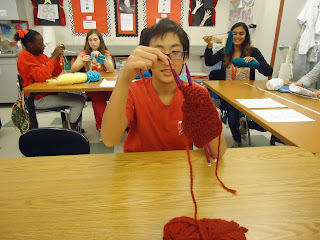This year we modified our knitting unit a couple of ways. first, we had the students handcraft their knitting needles out of wooden dowels as opposed to having them purchase needles. This was a little risky, I'll admit, but a way for us to keep cost down for the students and also teach them some resourcefulness. I would say that in the end, 80% completed their knitting project using their hand made needles while the other 20 ended up purchasing their own needles. I think making needles is worth it and there are ways to improve the overall quality of the needle that would decrease the percentage of needle buyers next year.
In addition to making needles which took one class period, we also spent only two weeks on knitting as opposed to 4 weeks. One week out of the two-week period was a minimum day week, too so we spent at least 50% less time on task in class producing blankets than we did last year. However, during the two week period our focus was directly on problem solving and knitting mastery. We taught and retaught how to solve increases and decreases, made students rip out knitting that had holes, and would only measure, thus give credit for knitting that demonstrated mastery.Once students finished their knitting projects they wove their strip into a blanket.
So with handcrafting needles, using limited time and requiring students know how to problem solve for high quality knitting we knitted less blankets but the students are much more knowledgeable knitters and more likely to knit successfully on their own in the future.
Sunday, December 8, 2013
Senior Project
PFAA Senior "Shuggy Barry" shook things up in Room I-5 this week during her senior project. Our 8th grade students learned about the 1950's era and the Broadway performance of Grease to help prepare them for their own Grease performance. In addition to learning about Grease, Shuggy led the students through multiple exercises including vocal warm-ups, singing warm-ups, stage annotation and theater games. Mr. Austin even stopped by for a visit while the kids were singing numbers. It was a fantastic workshop, one of the best that we have ever hosted and a great experience for our students.
Saturday, November 30, 2013
Graffiti
With the access to I-pads and Chromebooks in the classroom I feel compelled to expose students to digital art. There is fear in this, however, based on the assumption that the antiquity of handcrafted art forms may lose their appeal once students glean tricks from these flashy devises. So to counterbalance my curiosity as well as my fears, we piloted a Graffiti project that introduced GraffitiCreator, a web-based graffiti design website and had all of our students create a digital design based on a word that best described themselves. Once they created a design they liked, students took a screenshot and recreated the graffiti by hand with the goal of producing an even better design.
The topic of Graffiti was a great concern for us, too. I mean, we like our jobs and want to keep them! So, with taking on a socially controversial art form, we had to take time to analyze graffiti from several perspectives both locally and globally before diving deep into the discussion of whether Graffiti is an art from or vandalism. The internet is a wonderful tool for such analysis. Coincidentally, during this project an authentic controversy was brewing in NYC. The owner of 5 POINTZ, a privately owned apartment complex that has been an unofficial museum for graffiti artists around the word, announced demolition on 11/5/2013 which unleashed a myriad of appeals from graffiti artists around the world. The resonating message from the mass appeal was a need for acknowledgement and recognition that graffiti is indeed and art from and not vandalism. http://www.huffingtonpost.com/2013/10/11/5-pointz-demolition_n_4085315.html
In the end, students realized how challenging graffiti is to create. They were able to view graffiti wearing new shoes, the shoes of an artist. By doing so, some students took on new perspectives while others held strong to their original viewpoints of whether or not graffiti is art or vandalism. The overall goal was to have students experience something for themselves before making judgments of others. I think we achieved our goal.
The topic of Graffiti was a great concern for us, too. I mean, we like our jobs and want to keep them! So, with taking on a socially controversial art form, we had to take time to analyze graffiti from several perspectives both locally and globally before diving deep into the discussion of whether Graffiti is an art from or vandalism. The internet is a wonderful tool for such analysis. Coincidentally, during this project an authentic controversy was brewing in NYC. The owner of 5 POINTZ, a privately owned apartment complex that has been an unofficial museum for graffiti artists around the word, announced demolition on 11/5/2013 which unleashed a myriad of appeals from graffiti artists around the world. The resonating message from the mass appeal was a need for acknowledgement and recognition that graffiti is indeed and art from and not vandalism. http://www.huffingtonpost.com/2013/10/11/5-pointz-demolition_n_4085315.html
In the end, students realized how challenging graffiti is to create. They were able to view graffiti wearing new shoes, the shoes of an artist. By doing so, some students took on new perspectives while others held strong to their original viewpoints of whether or not graffiti is art or vandalism. The overall goal was to have students experience something for themselves before making judgments of others. I think we achieved our goal.
Subscribe to:
Comments (Atom)



















































